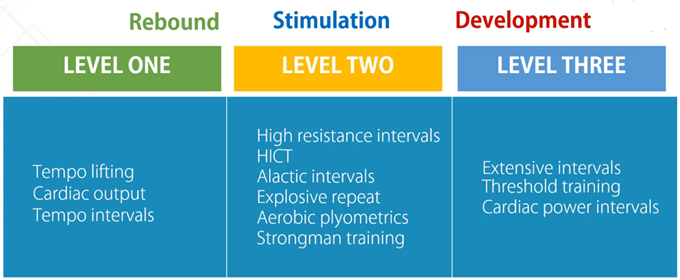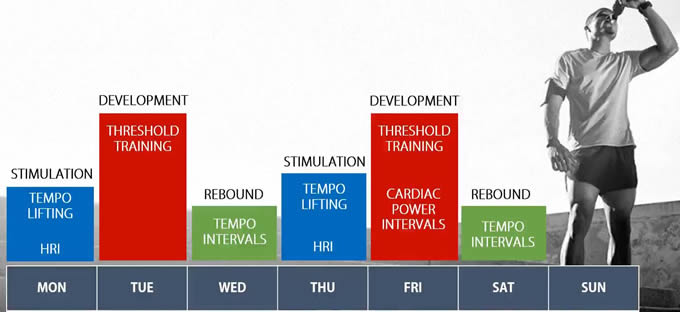Even though many people start writing programs by selecting methods and exercises, you should first lay the proper foundation by testing your conditioning (Day 1), setting goals (Day 2), and building your weekly plan (Day 3).
What is a training method?
A training method is a specific way of performing an exercise or movement that’s designed to trigger an improvement in fitness.
We generally characterize training methods by work to rest ratios, number of sets and reps, and movement speed/cadence.
It’s important to determine your methods before selecting your exercises, because methods define the overall effect that exercises will have.
Types of conditioning methods:
There are two broad types of conditioning methods: general conditioning and local muscular endurance.
General conditioning training methods improve energy system development and capacity. These involve a variety of movement patterns, depending on where you’re at in the training year.
Local muscular endurance methods develop postural and positional endurance to support better movement patterns. You should use specific exercises to target the weaknesses you identified in your assessment.
My top 5 training methods:
While we don’t have enough time here to cover all the conditioning methods I teach in my online conditioning certification, I’ve put together a cheat sheet with my top 5 conditioning methods for you to reference.
File download: My top 5 conditioning methods
Selecting training methods:
It’s important to consider the volume and intensity of each training method since this determines the amount of stress they impose on your body. I organize methods as level one, two, or three based on much stress they cause.
You should use low volume/intensity methods on Rebound days (level one), since they will not cause you to accumulate additional fatigue.
Perform moderate volume/intensity methods on stimulation days (level two), since these should induce enough stress to maintain your conditioning and prepare your body for Development days.
Use high volume/intensity methods on Development days (level three) to place enough stress on your body to cause it to adapt and improve your conditioning.

In a nutshell, it’s important to select the appropriate methods (based on the amount of stress they cause) for the training day goal you’ve set.
Picking exercises:
When you start to pick your exercises, you should first select movement patterns based on your specific weaknesses and sport demands. Then consider which exercises meet the method requirements for each training day category.
This is why it’s important to pick the methods first and let the proper exercises fall into place; only certain exercises meet specific method requirements.
You can see what I mean in this video on Tempo Intervals, a moderate-intensity method I’ve written extensively about in the past few years.
Building your exercise library:
If you’re a coach or you plan on creating a lot of conditioning programs, it’s easiest to have a system in place for choosing the appropriate exercises for movement pattern. You can also organize each exercise by the type of method it corresponds to.
I recommend building an exercise library that’s structured so you can drag and drop exercises into your program based on the kind of method and training day category you have scheduled.
To give you an idea of how to organize your methods and exercises in a weekly template, I have a sample program for you:

Today's challenge:
Your challenge today consists of three parts:
- Identify and build your training methods using my Top 5 Training Methods worksheet as an example [Download here]
- Create your own exercise library and make note of which exercises are appropriate for each type of training method
- Assign methods and exercises to the weekly plan you created in Day 3
On most training days, plan on using one or two methods. You should generally schedule the same method at least twice per week to give your body the opportunity to adapt to the stimulus it creates.
Tomorrow, we’re going to cover how to get the most out of your program using monitoring and management strategies.
If you’re a coach or trainer and want to truly master all the components of writing conditioning programs, I highly recommend getting on the free Insider’s List for my online conditioning certification before it closes on Sunday.
If you get on the list, you’ll save $200 off the full certification price and you’ll be able to reserve your spot when registration opens on September 10th.
You can join the free list by completing the form below: